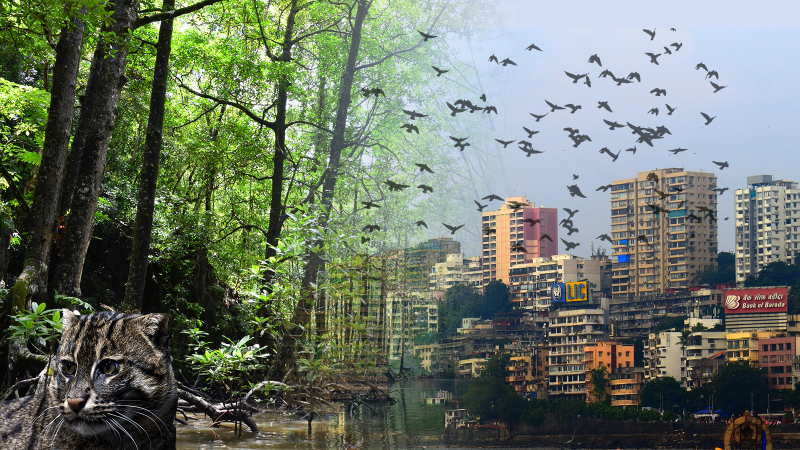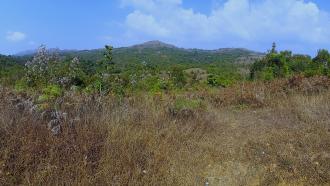
It’s not just humans who are struggling to find a space to live in the crowded city of Mumbai. A study has reported that the financial capital’s growing urban and peri-urban sprawl is still rich in wildlife but is forcing the animals to the city’s remaining few green fringes. The study, published in the journal PLOS ONE, was funded by the City and Industrial Development Corporation of Maharashtra and was carried out with the necessary permissions of the Maharashtra State Forest Department.
“A large part of the Mumbai Metropolitan Region (MMR) has been overlooked (for biodiversity studies), though it harbours rich and fascinating biodiversity. The region includes remnant primary forest tracts such as the Karnala Bird Sanctuary (KBS), Prabalgad-Matheran-Malanggad Hill Range (PMMHR) and Manikgad — forest patches that are typical of Western Ghats,” says Mr Sameer Bajaru, the paper’s lead author and researcher at the Bombay Natural History Society, Mumbai.
The study's main objective was to examine the impact of land use and land cover changes (driven by urbanisation) on amphibians, reptiles, birds, and mammals. The team recorded 213 species — 25 mammals, 135 birds, 16 amphibians, and 36 reptiles — and the effect of urbanisation on the overall species communities.
The city’s growing human population, currently at 26.6 million, occupies 603 sq. km and is expected to grow to 44 million by 2052, along with the expanse doubling up to 1050 sq km. These factors are eating into the city’s natural habitats, reducing its forest patches. Mangroves, Mumbai’s primary defence against floods, is also losing ground due to developmental activities.
Peri-urbanization or the rural areas transforming into extended urban regions is a prime example of how population expansion affects Mumbai’s forests. “As a result, landscapes, where agricultural land and forests coexist, are converted into or fragmented by urban-industrial landscapes. This has created complex mosaics of diverse land uses and land covers in all the ecosystems,” says Mr Bajaru.
The team sampled approximately 1976 sq. km of the MMR with the help of satellite images to identify land use and land cover under three major types: forest (11%), degraded forest (29%) and human habitat (45%). The team categorised the types into semi-evergreen, moist deciduous, mangrove, scrub, grassland, human settlement, and agriculture.
They then determined how each species had adjusted to land-use change, both individually and as part of a community with other species, by observing various factors. For mammals, they used camera trapping and visual surveys, also looking for indirect evidence such as scat, pellets, pugmarks, hoof marks, scratch marks, wallows, carcasses, and remains of body parts. For birds, a bird-watcher standing at fixed sampling points recorded all birds heard or seen within a 50m radius (known as the fixed-radius point count method). They marked quadrats with ropes for amphibians and reptiles, manually overturning leaf litter, branches, stones, and checked rock crevices, tree holes, fissures, and buttresses to look for them.
“We used an advanced and robust statistical model known as ‘multi-species occupancy modeling’ or MSOM for estimating the occurrence of different species and their response to land use and land cover change in MMR,” says Mr Bajaru. MSOM is a recent approach to finding out how multiple species interact and coexist in landscapes with different land uses.
Their findings showed that the species richness of mammals, birds, amphibians and reptiles peaked in forested areas.
“96% of mammals, 85% of birds, 93.75% of amphibians, and 69.43% of reptiles showed that species occupancy decreases where human habitat cover has increased. Whereas, in general, the forest cover had a positive effect on species occupancy,” he explains.
These species-rich forests are now confined to high altitude areas in MMR such as Matheran, Prabalgad, Malanggad, Manaikgad, and Karnala. The team suggests that steps should be taken to minimise or stop habitat loss due to development activities in these areas.

(Top right) Indian Mouse Deer (Moschiola indica) & (bottom left) Bombay Night Frog (Nyctibatrachus humayuni) - two endemic species of moist-deciduous forests of Karnala Bird Sanctuary, Mumbai.
(Images courtesy: Sameer Bajaru)
However, the team noticed notable deviations based on the species’ food preferences. For example, they found that the herbivores and carnivores were found more in the undisturbed forests. In comparison, omnivores and insectivores such as black kite, blue rock pigeon, common myna, Indian pond heron, red-wattled lapwing, house crow, and house sparrow had drifted towards human-inhabited areas and increased in these regions.
“These findings were not surprising because these species heavily depend on food produced in human-dominated landscapes,” says Mr Bajaru.
The team also checked how a particular site’s development history affected species’ occupancy. For example, Prabalgad fort and Matheran have undergone major historic transformations due to the timber trade in the pre-colonial and colonial eras. However, they were found to be less disturbed than other human-dominated areas and consequently rich in species.
Earlier, Matheran had moist-deciduous to semi-evergreen forests but was converted to a hill station in the 1850s. Due to the conversion and wood extraction and forest fires, the whole area transformed into open, dry deciduous and scrub forests.
Mr Bajaru says their preliminary study has generated diverse data, and there might be still more to discover, which can be done by long-term monitoring of the region. And also, by mobilising citizen science projects (involving participation and data collection by local citizens interested in documenting and preserving biodiversity), building nature interpretation centres for creating awareness among people about the local biodiversity conservation will be helpful.
But this will be possible only if the forest areas survive and thrive. For this, local participation is crucial, says Mr Bajaru.
“Forest staff and local people should be trained to develop nurseries of native moist-deciduous or semi-evergreen trees for restoring the degraded habitats. Private landowners around species-rich areas identified in this study should be encouraged to take conservation actions such as planting native trees grown in nurseries operated by forest staff and local people,” adds Mr Bajaru.
Planting native trees can restore primary forests, thereby increasing species diversity. However, this is impossible if more land is lost to developmental activities like building roads, railway tracks, and buildings that involve converting natural habitats into human-dominated ones. The local policymakers, the Forest Department, and local governing bodies like Mumbai Metropolitan Region Development Authority (MMRDA) and the City and Industrial Development Corporation (CIDCO) could initiate and fund the conservation programmes, suggest the authors.
This article has been run past the researchers, whose work is covered, to ensure accuracy.






